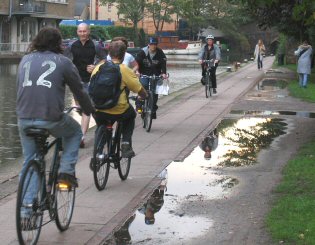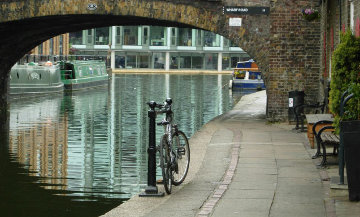REGULAR readers will be well aware of the long running controversy over speeding cyclists on the Regents Canal towpath and pedestrians, with British Waterways now coming up with its 'solution' that is considered flawed and misguided.
The proposals concern the towpath from Danbury Street to Sturts Locks, a third of a mile stretch running across borough boundaries between the London Borough of Islington and London Borough of Hackney, and Del Brenner, Secretary Regents Network and a member of the London Waterways Commission writes:
 The towpath is not wide enough for shared use with cyclists.
The towpath is not wide enough for shared use with cyclists.
The Government Guidance and Sustrans recommendations specify that the minimum width for shared use of a path should be 2m providing there is open space either side of the path. Most of this section of the Regents Canal is less than 2m wide with the canal on one side and brick walls on the other.
Too scared to use towpath
 There has been serious conflict in the area for years, and many locals and visitors no longer use the towpath, and now find alternative routes. This includes the pupils from the canalside primary school and a number of elderly and disabled locals who have been complaining that they are too scared to use the towpath.
There has been serious conflict in the area for years, and many locals and visitors no longer use the towpath, and now find alternative routes. This includes the pupils from the canalside primary school and a number of elderly and disabled locals who have been complaining that they are too scared to use the towpath.
This short section of towpath leads to the Islington Tunnel where cyclists have to return to the roads, and the obvious solution to the problems of conflict with pedestrians is for the cyclists to leave the towpath a short distance earlier and use an alternative route that is available.
 At the expense of boaters
At the expense of boaters
So what are British Waterways up to suggesting alterations which include widening the towpath into the canal itself, and reducing the navigation width at pinch points under bridge arches where handling boats is already challenging? Why do British Waterways consider that they should benefit cyclists at the expense of boaters?
Even though the general description of British Waterways role under the new Trust does not give much importance to navigation (perversely), the new Canal & River Trust (CART) will still basically be a navigation authority.
Handsome profit
British Waterways in London do not seem to be doing much for the benefit and maintenance of our canals, except when it involves cyclists. This is because they can get the money (public funds) from Transport for London (TfL) and which includes a handsome profit for British Waterways on each project.
It has been many years since TfL provided any funds for the canal with dredging and the like, and although TfL claim that it supports the canals in London by providing vast sums of cash on a regular basis, it is all spent on cyclists.
Flawed and misguided scheme
I strongly oppose the British Waterways proposal for what is loosely referred to as ‘improvements to shared use' of the Regents Canal towpath between Danbury Street and Sturts Locks as it is a thoroughly flawed and misguided scheme. And I object to public funds being spent on a half-baked project.
As is generally accepted by the great majority, cycling is fully supported and welcome. Canal users, including myself, also encourage cycling provided it is carried out on the stretches of canal towpaths that are wide enough to accommodate shared use with safety. Unfortunately much of London's towpaths are narrow and there are many pinch points at bridges and the like, so we do not consider that our towpaths are suitable as a cycling highway (a British Waterways description).
In control of everything
British Waterways are soon to carry out a Risk Assessment on this Regents Canal Cycling Project, as they call it, rather than a pedestrian and towpath users project (and forget the boats). Unfortunately it is not being carried out at arms length, as British Waterways itself will be involved in the risk report, which is a typical British Waterways approach as it has to be in strict control of everything. Will it ever learn?
Fortunately, this ‘towpath alterations' scheme will have further scrutiny as it is subject to planning consent in two boroughs, and it cannot be carried out as ‘permitted development' as you can hardly describe a scheme for benefit of cyclists as a waterways ‘operational' matter.
To save the bother of all that, it is hoped that British Waterways will get the message that this is an unpopular and flawed project, and it will drop it. Fingers crossed that British Waterways will listen for once.
